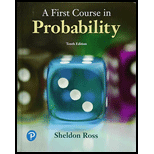
EBK FIRST COURSE IN PROBABILITY, A
10th Edition
ISBN: 9780134753676
Author: Ross
Publisher: PEARSON CUSTOM PUB.(CONSIGNMENT)
expand_more
expand_more
format_list_bulleted
Concept explainers
Textbook Question
Chapter 10, Problem 10.4STPE
If X is a normal random variable with
Expert Solution & Answer
Want to see the full answer?
Check out a sample textbook solution
Students have asked these similar questions
Patterns in Floor Tiling A square floor is to be tiled with square tiles as shown. There are blue tiles on the main diagonals and red tiles everywhere else.
In all cases, both blue and red tiles must be used. and the two diagonals must have a common blue tile at the center of the floor.
If 81 blue tiles will be used, how many red tiles will be needed?
For what numbers in place of 81 would this problem still be solvable?
Find an expression in k giving the number of red tiles required in general.
At a BBQ, you can choose to eat a burger, hotdog or pizza. you can choose to drink water, juice or pop. If you choose your meal at random, what is the probability that you will choose juice and a hot dog? What is the probability that you will not choose a burger and choose either water or pop?
a card is drawn from a standard deck of 52 cards. If a card is choosen at random, what is the probability that the card is a)heart b)a face card or c)a spade or 10
Chapter 10 Solutions
EBK FIRST COURSE IN PROBABILITY, A
Ch. 10 - The following algorithm will generate a random...Ch. 10 - Prob. 10.2PCh. 10 - Give a technique for simulating a random variable...Ch. 10 - Present a method for simulating a random variable...Ch. 10 - Use the inverse transformation method to present...Ch. 10 - Give a method for simulating a random variable...Ch. 10 - Let F be the distribution functionF(x)=xn0x1 a....Ch. 10 - Prob. 10.8PCh. 10 - Suppose we have a method for simulating random...Ch. 10 - Prob. 10.10P
Ch. 10 - Use the rejection method with g(x)=1,0x1, to...Ch. 10 - Prob. 10.12PCh. 10 - Prob. 10.13PCh. 10 - Prob. 10.14PCh. 10 - Prob. 10.15PCh. 10 - Let X be a random variable on (0, 1) whose density...Ch. 10 - Prob. 10.1STPECh. 10 - Prob. 10.2STPECh. 10 - Prob. 10.3STPECh. 10 - If X is a normal random variable with mean and...Ch. 10 - Prob. 10.5STPE
Knowledge Booster
Learn more about
Need a deep-dive on the concept behind this application? Look no further. Learn more about this topic, probability and related others by exploring similar questions and additional content below.Similar questions
- in a coffee shop, 160 customers came in. Of these, 60 bought coffe and cake and the rest ordered just coffee. determine the probability that the next person will buy coffee and cakearrow_forwardTwo dice are rolled and their sum calculated. Draw a table to show all of the possibilities. Determine the theoretical probability of rolling a sum of 7. And determine the theoretical probability of rolling a sum greater than 9arrow_forwardA football player makes 350 out of every 400 passes he throws. In a game he usually throws 26 passes. Estimate how many of these passes will be successfularrow_forward
- Q prove or disprove: If Ely/x) = x = c(dipy =BCCo (BVC) ECxly)=y, and E(X2), Ely)arrow_forwardIn a small office, there are m = 5 typists who need to use a single typewriter to complete their reports. Assume the time each typist takes to prepare a report follows an exponential distribution with an average of 20 minutes per preparation (A = 3 reports/hour), and the service time for the typewriter to type out a report also follows an exponential distribution, averaging 30 minutes to complete a report (μ 2 reports/hour). Given that the number of typists is finite and all typists = share one typewriter, they will form a waiting queue. (1). Describe this queuing system and explain how it fits the characteristics of the M/M/1/∞0/m model. (2). Calculate the probability that any typist is using the typewriter at steady-state. (3). Calculate the average number of typists waiting in the queue at steady-state. (4). Considering the need to reduce waiting time, if an additional typewriter is introduced (turning into a two-server system, or M/M/2/∞0/m model), analyze the expected impact,…arrow_forwardCan you tell the answerarrow_forwardTheorem 2.4 (The Hölder inequality) Let p+q=1. If E|X|P < ∞ and E|Y| < ∞, then . EXY SEXY ≤ Xp Yq.arrow_forward2 P(x,y). kx²y X: 1,2 5.11273 Find k Find P(x/y) ③ Mxy Ng q oxy วarrow_forwardThe joint density function of two continuous random variables X and Y is: p(x, y) = {Kcos(x + y) Find (i) the constant K 0 0arrow_forwardp(x,y) = {e-x -(x+y) 0 x ≥ 0, y ≥ 0 otherwise find x,y,Exy, by Охarrow_forwardIf X is a continuous random variable having pdf as shown. Find a) the constant k b) P(X>1) c) X, X², 0%, standard deviation. n(x) k -2 -1 0 1 2arrow_forwardThe joint probability function for the random variables X and Y is y 0 1 2 P(X, Y) = x0 [3/28 9/28 3/281 = 13/14 3/14 2 1/28 0 0 0 Find Mx, My, E(XY), OXY.arrow_forwardarrow_back_iosSEE MORE QUESTIONSarrow_forward_iosRecommended textbooks for you
 Holt Mcdougal Larson Pre-algebra: Student Edition...AlgebraISBN:9780547587776Author:HOLT MCDOUGALPublisher:HOLT MCDOUGAL
Holt Mcdougal Larson Pre-algebra: Student Edition...AlgebraISBN:9780547587776Author:HOLT MCDOUGALPublisher:HOLT MCDOUGAL Glencoe Algebra 1, Student Edition, 9780079039897...AlgebraISBN:9780079039897Author:CarterPublisher:McGraw Hill
Glencoe Algebra 1, Student Edition, 9780079039897...AlgebraISBN:9780079039897Author:CarterPublisher:McGraw Hill
 Holt Mcdougal Larson Pre-algebra: Student Edition...AlgebraISBN:9780547587776Author:HOLT MCDOUGALPublisher:HOLT MCDOUGAL
Holt Mcdougal Larson Pre-algebra: Student Edition...AlgebraISBN:9780547587776Author:HOLT MCDOUGALPublisher:HOLT MCDOUGAL Glencoe Algebra 1, Student Edition, 9780079039897...AlgebraISBN:9780079039897Author:CarterPublisher:McGraw Hill
Glencoe Algebra 1, Student Edition, 9780079039897...AlgebraISBN:9780079039897Author:CarterPublisher:McGraw Hill
Continuous Probability Distributions - Basic Introduction; Author: The Organic Chemistry Tutor;https://www.youtube.com/watch?v=QxqxdQ_g2uw;License: Standard YouTube License, CC-BY
Probability Density Function (p.d.f.) Finding k (Part 1) | ExamSolutions; Author: ExamSolutions;https://www.youtube.com/watch?v=RsuS2ehsTDM;License: Standard YouTube License, CC-BY
Find the value of k so that the Function is a Probability Density Function; Author: The Math Sorcerer;https://www.youtube.com/watch?v=QqoCZWrVnbA;License: Standard Youtube License